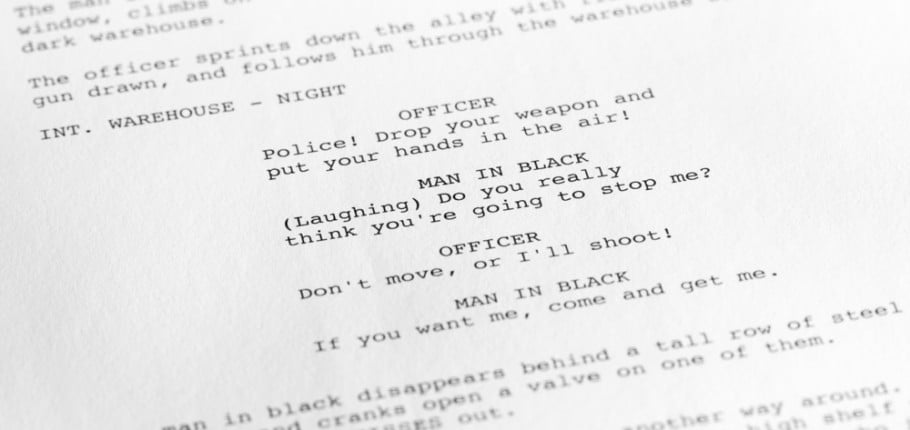
Screenwriting 101: How to Read a Screenplay
Screenplays are strange beasts. They’re one part blue print, one part novel, and one part play. Thanks to this fact, knowing how to read a screenplay can be quite confusing for people who are trying it for the first time. Screenplays or scripts as they’re also called, tend to vacillate wildly from large blocks of text to simple paired-down, itty bitty lines of dialogue that might leave you sad for the trees. Want to write screenplays well? Then you most certainly need to know how to read them, injesting all their various elements quickly and correctly. If you plan on going pro, this is water you’ll be wading in soon. Many professionals in the movie making business read upwards of 2 to 3 screenplays a night, and people who work in studio development can read as many as 10 scripts in an evening. So what’s the average reading speed for these pros? A page a minute which is roughly the same in “playing time” i.e. meaning a 112 page screenplay will have a playing time of approximately 112 minutes.
The first thing you should understand when reading scene descriptions are the terms INT. and EXT. Those mean “interior” and “exterior”. They denote where the scene you’re reading takes place. Some writers will then elaborate on the contents of the room or the appearance of the outside of a building, some will immediately move on to the next piece of the narrative puzzle which is most often “ACTION” in caps, after which a few lines cue you into the action that’t taking place. The tense for such sentences is present tense. Example: The back door swings open. Sara walks through it, passes the bar, and slides into a large booth.
The next thing that throws some people off is “(O.S.)” or “(O.C.)”. If either one of those descriptions appears next to a characters lines the mean that they are “off camera” or “off screen.” This is usually used in reveals or when a characters identity is being kept secret. Another common abbreviation you’ll find next to characters’ names is “(V.O)” for “voice over.”
Parentheticals are the words that appear in parentheses directly under a character’s name, telling you something essential about the character’s behavior. This something should use language that’s visceral and can be seen. For instance, rather than writing “(angrily)” you would write “(screaming).” Try not to overuse your parentheticals. The rule of thumb is that if a reader would already assume that’s the emotion without the addition of a parenthetical, then leave it off.
From there, there are also some formatting things that you should keep in mind when you’re reading. The first act climax, i.e. when the character should make the decision about what they’re going to do for the rest of the movie or the “Call To Action” should take place, should happen at or between page 15 to page 20. Then, there should be a second act climax, where things should get worse, and the character should question the decision they’ve been committing to, then double down even harder. This happens around page 60. Finally, look for the third act climax where the plot comes to a resolution and the character should learn the lesson associated with the decision they’ve been living. This should happen at about page 80. That should leave around 10 to 15 pages of “denouement” screen time. Meaning, there should be some loose ends tied up, characters saying goodbye, perhaps a glimpse of the new reality that has set in, after the character has persevered and won. This is what brings the movie to a close and, ideally, leaves us, the reader/audience with a sense of fulfillment.
Half technical jargon, half meticulous micromanaged expression of creativity, therein lies the dichotomy of the creative screenwriter. The medium is a blueprint for the story that appears on the screen, including essential physical cues like location, time of day, general enviroment, etcetera. A good screenplay is both interesting to read and well constructed, in terms of format and layout and as such, allows for the reader to “watch” the film in their mind’s eye with nary a glitch or distraction. Often times, new screenwriters will try and break the mold. They’ll try to formulate things in new or different ways and they’ll attempt to showcase their own individuality by presenting the reader with alternatives to what is traditionally displayed in a screenplay. This can work for you or against you with dire consequences. Screenplays which vary from traditional format can get tossed into the trash bin without a read. This is common practice in a number of studio development offices. The argument for such a strict policy is that screenplays that do not adhere to traditional format are essentially unreadable because they do not allow for a studio’s readers to “see” the movie as they read it. Deviate from the standard format and it’s a roll of the dice as to whether it will help you or hurt you.
When reading a screenplay, the most important thing you should be asking yourself is “Is this interesting?” If you’re constantly engrossed in what’s happening, then formatting and traditional structure aside, you’re reading a promising script. Scripts often evolve and change over their creative lifetime, so if the script is compelling, it’s worth holding onto for a second and third read, and a potential candidate for getting made.
Writing a screenplay is hard. Writing a good screenplay is much, much harder. Writing a screenplay that’s good and that will sell, well that’s just what most aspiring screenwriters are trying to achieve. Other writers write stellar screenplays but seem to loathe marketable stories and so they’re relegated to being niche writers whose success depends on whether they’re ever able to connect their work to their audience. Other writers write stuff that screams “marketable” and contrary to what many people think of studio executives, all readers, even those at Sony, yearn for a little soul, a little sustenance, even in their adrenaline ridden movies full of car chases and shoot out scenes.
So you want to write the next great American screenplay? Then, get to reading! One quick way to educate yourself is to read the screenplays for some of cinema’s greatest, movies like The Graduate, The Godfather, Casablanca, Vertigo, and other greats. After you’ve read the screenplay, watch the movie. You’ll undoubtedly find differences between script and final film and you’ll also gain a window into your own internal mind’s eye imagination. This ability to “see” and understand the mechanics and art that goes into effective script writing can be developed over time and once you have it, reading screenplays, or rather, reading good screenplays becomes a joy, not a burden. Master the reading and, chances are, the writing will soon follow.
More on Screenwriting 101.
Learn more about hands-on training from within the film industry.
The real-world approach to filmmaking.



